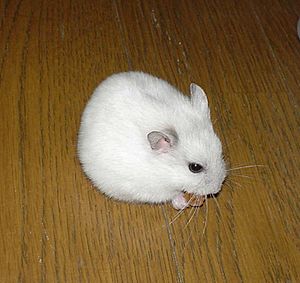Dwarf hamster facts for kids
Quick facts for kids Dwarf hamstersTemporal range: Pleistocene to Recent
|
|
|---|---|
 |
|
| Dwarf winter white Russian hamster | |
| Scientific classification | |
| Kingdom: | |
| Phylum: | |
| Class: | |
| Order: | |
| Superfamily: | |
| Family: | |
| Subfamily: | |
| Genus: |
Phodopus
Miller, 1910
|
Dwarf hamsters are a group of small, furry animals. They belong to a scientific group called Phodopus. Even though the Chinese hamster isn't in this group, people often call it a dwarf hamster too.
These tiny hamsters are a great choice for pet owners. They are smaller than the Syrian hamster and often enjoy being with other hamsters. A scientist named W.C. Campbell first discovered them in the early 1900s.
Contents
Types of Dwarf Hamsters
There are several types of dwarf hamsters. Each one has its own special look and features.
Campbell's Dwarf Hamster
The Campbell's dwarf hamster, known scientifically as Phodopus campbelli, has white fur on its lips and cheeks. The area around its ears is grey. A dark stripe runs down its back, from its neck to its tail. Its throat, belly, and legs are white. The tops of its paws are a shiny silvery white. When this hamster fills its cheek pouches with food, they can stretch all the way back to its shoulders! An average adult weighs about 23 grams.
Winter White Dwarf Hamster
The Winter White dwarf hamster, or Phodopus sungorus, changes its fur color with the seasons. In summer, its face is brown, with lighter fur around its mouth and ears. The rest of its head is dark brown, and it has a black ring around each eye. A dark brown stripe goes from the back of its head to its tail. Its feet, tail, throat, and belly are white. Its back can be ash grey to dark brown. In winter, its fur often turns mostly white to blend in with snow.
Roborovski Hamster
The Roborovski hamster, Phodopus roborovskii, is the smallest type of Phodopus hamster. In fact, it's the smallest hamster species overall! Its feet are quite short, wide, and very hairy. The fur on its belly is grey. When it sheds its fur, its coat color can also turn grey.
How Dwarf Hamsters Survive Cold and Heat
Dwarf hamsters live in places that can get very cold in winter. To stay warm, they have round, compact bodies. They also have thick fur and a layer of fat that helps keep them insulated, like wearing a warm coat. Water can be hard to find, so they are very good at saving water. They don't lose much water through their skin and can make their pee very concentrated.
When it's super cold (below -20°C), the Winter White hamster has a special trick. It hunches its body, tucking its head and front paws under its belly. It also fluffs up its fur evenly, which traps more air and makes it even warmer.
When it's very hot (above 30°C), this hamster does the opposite. It flattens itself on its belly, spreading out all four legs. It also grooms its fur into small clumps. This creates little "ventilation gaps" between the clumps, helping air flow and cool it down.
What Dwarf Hamsters Eat
In the wild, Phodopus hamsters mainly gather and eat seeds and dry fruits. They also munch on other parts of plants and sometimes eat insects.
Where Dwarf Hamsters Live
Phodopus hamsters live in mountainous forests, grasslands, and semi-deserts. You can find them in Mongolia and nearby areas like China, Kazakhstan, and parts of Russia. All three species are common, but some small groups live in isolated spots.
Dwarf Hamsters and People
Dwarf hamsters became popular pets in the mid-1990s. They are considered excellent pets, especially for people new to owning hamsters. This is because they are easy to care for and don't need special diets or living conditions. They are also generally not aggressive towards people and can live peacefully with other hamsters of their own kind.
Scientists also use Phodopus hamsters in laboratories. They have been helpful in research, including studies about cancer.
Images for kids




